Elephant Management and Poaching in African Countries
- Richprins
- Committee Member
- Posts: 75960
- Joined: Sat May 19, 2012 3:52 pm
- Location: NELSPRUIT
- Contact:
Re: Elephant Management and Poaching in Other African Countries
Indeed! 
Please check Needs Attention pre-booking: https://africawild-forum.com/viewtopic.php?f=322&t=596
- Lisbeth
- Site Admin
- Posts: 67384
- Joined: Sat May 19, 2012 12:31 pm
- Country: Switzerland
- Location: Lugano
- Contact:
Re: Elephant Management and Poaching in Other African Countries
Botswana wants to draw a line under their elephant deaths – not so fast!
BY PIETER KAT - 21ST SEPTEMBER 2020 - FACEBOOK
In a press conference today, the Deputy Director and Chief Veterinary Officer of the Botswana Department of Wildlife and National Parks presented little convincing information to support their claim that “cyanotoxins” were responsible for well over 300 elephant deaths in a limited area of northern Botswana.
Crucial evidence was not presented as to the reasons and justification for their identification of Cyanobacteria occurring in eutrophic water holes as having caused the deaths of so many elephants. Also missing was any explanation as to why it was only elephants that died (apart from a weak suggestion that elephants “drink deep” from water holes and therefore might “suck up toxins”), why the elephants that died were limited to a relatively small area of northern Botswana (the same environment and waterholes are present across wide swathes of northern Botswana). Also, there was no discussion of which laboratories were sent samples and the capabilities of those laboratories, what samples were sent, the adequacy of those samples to perform tests (condition of the samples) and the diversity of samples that were sent (blood, internal organs, brain, stomach contents, etc).
So overall the case was not adequately made, despite being picked up quickly by Al Jazeera and Bloomberg reporting basically that the “mystery” was now solved…
Determining the presence of cyanotoxins is not a simple job. Cyanobacteria comprise a great diversity of species, some of which produce cyanotoxins while others do not. Also, among those that produce cyanotoxins, they do not always do so. Additionally, the toxins produced fall into a diversity of classes with different effects on the animal that ingests them.
The symptoms seen were neurotoxic, and those toxins are produced by a relatively small small group of Cyanobacteria. Detecting the presence of these cyanotoxins requires expertise and well-equipped laboratories, and tests relying on one particular method are not always reliable.
For those interested, there is a comprehensive publication by the EU on pros, cons, difficulties and limits of tests for cyanotoxins (https://op.europa.eu/…/c61665a1-45ab-11e7…/language-en). Their summary is as follows:
“In this report, attention is focused on the methodologies commonly used to detect cyanotoxins in water environments. These applications can be grouped in: I) microscopy analysis II) physicochemical methods III) molecular-based methods IV) biochemical based methods V) chemical methods. Each technique shows specific limitations in terms of sensitivity, reliability and limit of detection. The choice of the best one to use is determined in accordance with the information they provide, the availability of facilities and the technical expertise of the operators. Most of the research about cyanotoxins has been mainly focused on microcystins (MCs). The other cyanotoxins have been much less investigated and more tools need to be developed to overcome this problem. Notwithstanding there is no a single analytical application able to detect all cyanotoxin variants in an environmental sample.”
Microcystins are not neurotoxic.
So overall, the Botswana government has a long way to go to convince that the highly specific mortalities among elephants were directly related to neurotoxic cyanotoxins. Access should be provided to the laboratory reports, the specific methodologies used, the reliability of those methodologies and the quality of samples provided.
See news article here: https://www.aljazeera.com/news/2020/09/ ... tTaabttaCQ
BY PIETER KAT - 21ST SEPTEMBER 2020 - FACEBOOK
In a press conference today, the Deputy Director and Chief Veterinary Officer of the Botswana Department of Wildlife and National Parks presented little convincing information to support their claim that “cyanotoxins” were responsible for well over 300 elephant deaths in a limited area of northern Botswana.
Crucial evidence was not presented as to the reasons and justification for their identification of Cyanobacteria occurring in eutrophic water holes as having caused the deaths of so many elephants. Also missing was any explanation as to why it was only elephants that died (apart from a weak suggestion that elephants “drink deep” from water holes and therefore might “suck up toxins”), why the elephants that died were limited to a relatively small area of northern Botswana (the same environment and waterholes are present across wide swathes of northern Botswana). Also, there was no discussion of which laboratories were sent samples and the capabilities of those laboratories, what samples were sent, the adequacy of those samples to perform tests (condition of the samples) and the diversity of samples that were sent (blood, internal organs, brain, stomach contents, etc).
So overall the case was not adequately made, despite being picked up quickly by Al Jazeera and Bloomberg reporting basically that the “mystery” was now solved…
Determining the presence of cyanotoxins is not a simple job. Cyanobacteria comprise a great diversity of species, some of which produce cyanotoxins while others do not. Also, among those that produce cyanotoxins, they do not always do so. Additionally, the toxins produced fall into a diversity of classes with different effects on the animal that ingests them.
The symptoms seen were neurotoxic, and those toxins are produced by a relatively small small group of Cyanobacteria. Detecting the presence of these cyanotoxins requires expertise and well-equipped laboratories, and tests relying on one particular method are not always reliable.
For those interested, there is a comprehensive publication by the EU on pros, cons, difficulties and limits of tests for cyanotoxins (https://op.europa.eu/…/c61665a1-45ab-11e7…/language-en). Their summary is as follows:
“In this report, attention is focused on the methodologies commonly used to detect cyanotoxins in water environments. These applications can be grouped in: I) microscopy analysis II) physicochemical methods III) molecular-based methods IV) biochemical based methods V) chemical methods. Each technique shows specific limitations in terms of sensitivity, reliability and limit of detection. The choice of the best one to use is determined in accordance with the information they provide, the availability of facilities and the technical expertise of the operators. Most of the research about cyanotoxins has been mainly focused on microcystins (MCs). The other cyanotoxins have been much less investigated and more tools need to be developed to overcome this problem. Notwithstanding there is no a single analytical application able to detect all cyanotoxin variants in an environmental sample.”
Microcystins are not neurotoxic.
So overall, the Botswana government has a long way to go to convince that the highly specific mortalities among elephants were directly related to neurotoxic cyanotoxins. Access should be provided to the laboratory reports, the specific methodologies used, the reliability of those methodologies and the quality of samples provided.
See news article here: https://www.aljazeera.com/news/2020/09/ ... tTaabttaCQ
"Education is the most powerful weapon which you can use to change the world." Nelson Mandela
The desire for equality must never exceed the demands of knowledge
The desire for equality must never exceed the demands of knowledge
- Richprins
- Committee Member
- Posts: 75960
- Joined: Sat May 19, 2012 3:52 pm
- Location: NELSPRUIT
- Contact:
Re: Elephant Management and Poaching in Other African Countries
Please check Needs Attention pre-booking: https://africawild-forum.com/viewtopic.php?f=322&t=596
-
Klipspringer
- Global Moderator
- Posts: 5862
- Joined: Sat Sep 14, 2013 12:34 pm
- Country: Germany
- Contact:
Re: Elephant Management and Poaching in Other African Countries
https://www.reuters.com/article/us-nami ... SKBN28C2TH?
DECEMBER 2, 20206:48 PMUPDATED 21 HOURS AGO
Namibia to auction 170 elephants over drought, increased population
By Reuters Staff
WINDHOEK (Reuters) - Namibia has put 170 “high value” wild elephants up for sale due to drought and an increase in elephant numbers, the southern African country’s environmental ministry said on Wednesday.
An advertisement carried by state-owned daily New Era said an increase in incidents of human-elephant conflict motivated the sale of the large mammal that is at risk of extinction due to poaching and ecological factors.
The Ministry of Environment Forestry and Tourism said it would auction the animals to anyone in Namibia or abroad who could meet the strict criteria, which include quarantine facilities and a game-proof fence certificate for the property where the elephants will be kept.
Foreign buyers must also provide proof that conservation authorities in their countries will permit them to export elephants to their countries.
Like several other African nations, Namibia is trying to strike a balance between protecting high-value species like elephants and rhinos, while managing the danger they pose when they encroach on areas of human habitation.
Namibia’s conservation drive, which has seen its elephant population jump from around 7,500 in 1995 to 24,000 in 2019 according to government figures, has enjoyed international support.
But last year Namibia said it was considering withdrawing from the rules that govern the global trade in endangered species. This was after countries voted during a CITES meeting to reject proposals to relax restrictions on hunting and exporting its white rhinos
The country wants to allow more trophy hunting and the export of live animals, arguing that the funds it would raise would help it to protect the species.
In October it put 70 female and 30 male buffalos from Waterberg Plateau Park in central Namibia up for sale in a bid to ease pressure on grazing land.
The arid southern African nation also auctioned 1,000 animals from national parks, including 500 buffalos in 2019 as it faced the worst drought in a century.
DECEMBER 2, 20206:48 PMUPDATED 21 HOURS AGO
Namibia to auction 170 elephants over drought, increased population
By Reuters Staff
WINDHOEK (Reuters) - Namibia has put 170 “high value” wild elephants up for sale due to drought and an increase in elephant numbers, the southern African country’s environmental ministry said on Wednesday.
An advertisement carried by state-owned daily New Era said an increase in incidents of human-elephant conflict motivated the sale of the large mammal that is at risk of extinction due to poaching and ecological factors.
The Ministry of Environment Forestry and Tourism said it would auction the animals to anyone in Namibia or abroad who could meet the strict criteria, which include quarantine facilities and a game-proof fence certificate for the property where the elephants will be kept.
Foreign buyers must also provide proof that conservation authorities in their countries will permit them to export elephants to their countries.
Like several other African nations, Namibia is trying to strike a balance between protecting high-value species like elephants and rhinos, while managing the danger they pose when they encroach on areas of human habitation.
Namibia’s conservation drive, which has seen its elephant population jump from around 7,500 in 1995 to 24,000 in 2019 according to government figures, has enjoyed international support.
But last year Namibia said it was considering withdrawing from the rules that govern the global trade in endangered species. This was after countries voted during a CITES meeting to reject proposals to relax restrictions on hunting and exporting its white rhinos
The country wants to allow more trophy hunting and the export of live animals, arguing that the funds it would raise would help it to protect the species.
In October it put 70 female and 30 male buffalos from Waterberg Plateau Park in central Namibia up for sale in a bid to ease pressure on grazing land.
The arid southern African nation also auctioned 1,000 animals from national parks, including 500 buffalos in 2019 as it faced the worst drought in a century.
- Lisbeth
- Site Admin
- Posts: 67384
- Joined: Sat May 19, 2012 12:31 pm
- Country: Switzerland
- Location: Lugano
- Contact:
Re: Elephant Management and Poaching in Other African Countries
Would it not be better to cull them 
"Education is the most powerful weapon which you can use to change the world." Nelson Mandela
The desire for equality must never exceed the demands of knowledge
The desire for equality must never exceed the demands of knowledge
- Lisbeth
- Site Admin
- Posts: 67384
- Joined: Sat May 19, 2012 12:31 pm
- Country: Switzerland
- Location: Lugano
- Contact:
Re: Elephant Management and Poaching in Other African Countries
Herd opportunity: Hundreds of elephants return to DRC’s Virunga
by Elizabeth Claire Alberts on 10 December 2020
“Now not only are we seeing the elephants, which is an unbelievable sight from above, but we’re noticing the impact of such a big herd on the park,” Caere said in a statement. “They’re restoring everything back to what it was 50 years ago and doing [it] so much faster than we could have imagined. If the elephants continue to stay here in these numbers, this place will look totally different in just a few years.”
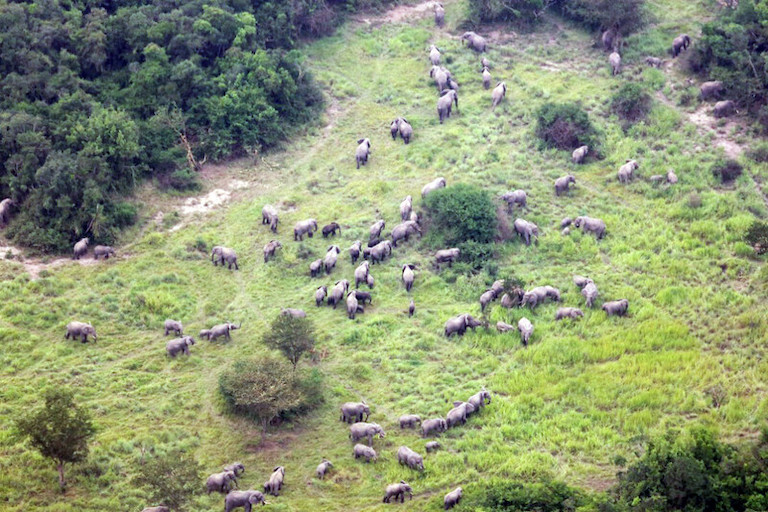
Savanna elephants roaming through Virunga National Park. Image by Virunga National Park.
These returning elephants join an existing population of about 120 elephants already in the park, forming a cumulative group of approximately 700 individuals.
Virunga National Park, a 790,000-hectare (2-million-acre) stretch of land on the eastern border of the DRC, is known for its rich diversity of habitats and rare wildlife — but also for its violent history. For decades, anti-government rebels and local militia groups have besieged the park, waging war with Virunga’s team of about 700 rangers tasked with protecting the park and its visitors. Virunga experienced one of its deadliest assaults this past April when armed militia killed 12 rangers, a park driver and four civilians. The park also experienced a spate of attacks in 2018, which took the lives of several Virunga guards and forced the park to close for eight months.
The COVID-19 pandemic has complicated matters further. The park closed again in May 2020 to protect its populations of critically endangered mountain gorillas as the coronavirus spread across the world. During this period, poaching incidents increased, and 40% of the park’s revenue dried up, a spokesperson for Virunga told Mongabay in an email.
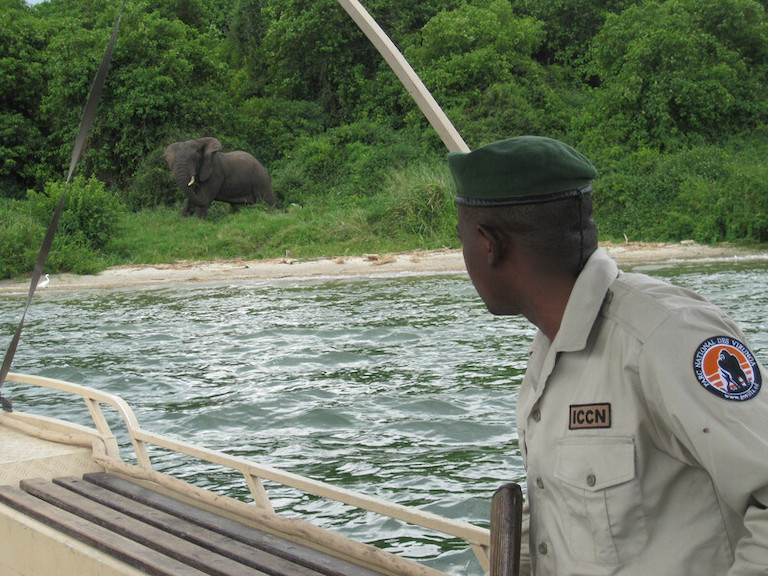
A park ranger observing an elephant. Image by Virunga National Park.
“The financial damage to Virunga National Park and the local economy of the closure of tourism activities is extremely serious,” the spokesperson said. “The local economy and population, being direct beneficiaries of the tourism industry, are facing significant economic strain.”
Despite the many challenges this year has presented, the Virunga team has been steadily working to improve security while protecting the park’s wildlife and their critical habitats with help from organizations such as Global Wildlife Conservation. The reappearance of the savanna elephants has assured the team that their hard work is paying off.
“[T]he return of the elephants … provides a real beacon of hope to conservation efforts around the world that are taking place in challenging contexts and which have been made even more difficult as a result of the impact of COVID-19,” the Virunga spokesperson said.
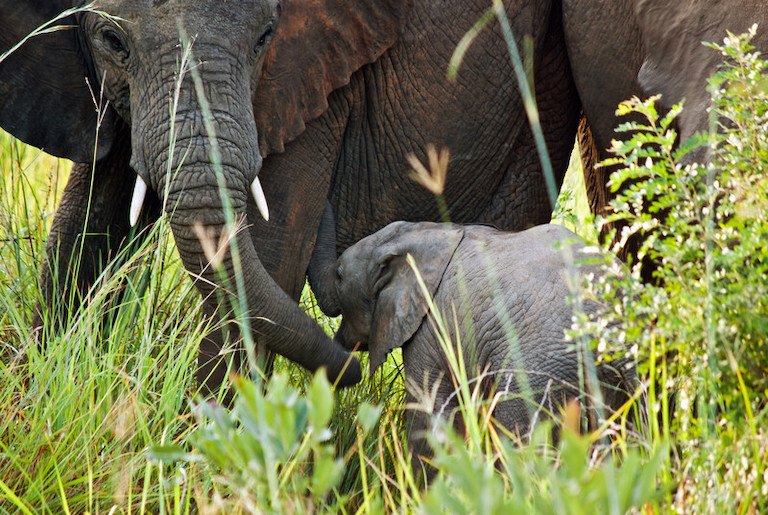
A mother and baby savanna elephant in Virunga. Image by Virunga National Park.
The elephants could be a harbinger for other positive changes in the park, including the return of other species, according to the Virunga team.
“[A]s the elephants return they tear through the trees and pummel invasive bushes, and so they are also transforming the landscape back to a true grassland savanna, allowing the return of grazers and other wildlife species that have been absent from the park for the last two decades: buffalo, Ugandan kob, warthogs, topi, and even a pair of lions,” they said. “Essentially the land is returning to its previous state.”
Iain Douglas-Hamilton, founder and president of Kenya-based charity Save the Elephants, said his organization helped put satellite collars on 15 of Virunga’s elephants in 2015 as park staff worked to protect them from poaching. Over the course of three years, two of the elephants were illegally killed, but the other 13 moved across the border between Virunga and the Queen Elizabeth National Park in Uganda, he said. But now, these same elephants seem to have returned.
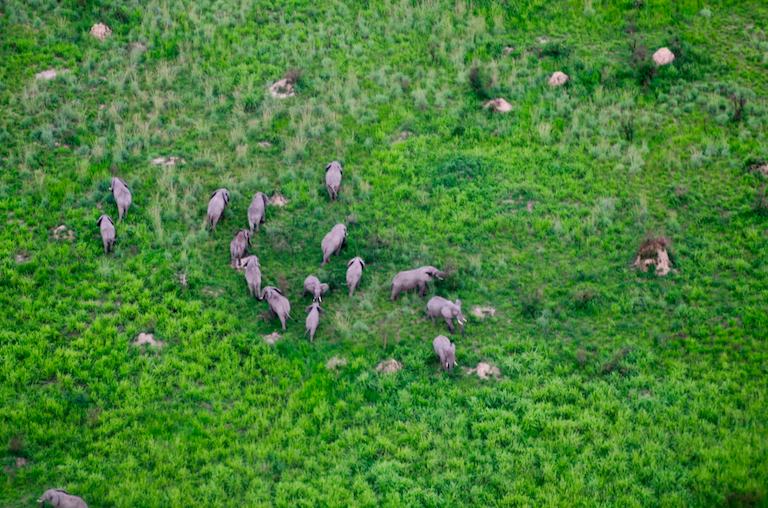
A group of elephants in Virunga. Image by Virunga National Park.
“It is very encouraging now to see that large numbers of elephants are taking up their residence in Virunga,” Douglas-Hamilton told Mongabay in an email. “There used to be about 8,000 back in the 1950s, but they were greatly reduced, and by the time Paul Allen’s Great Elephant Count came to the park in 2014, the team found only about 300 and they were thought to be critically endangered. If they can be protected they may once again regain their former numbers.”
He added: “[L]aw and order, peace and stability is what is needed and the chance gradually to build the national park service, as the guardians of this extraordinary landscape and its fauna and flora, and the acceptance of nature as an essential part of people’s existence.”
Elizabeth Claire Alberts is a staff writer for Mongabay. Follow her on Twitter @ECAlberts.
by Elizabeth Claire Alberts on 10 December 2020
- A group of about 580 savanna elephants recently returned to Virunga National Park in the Democratic Republic of the Congo after crossing over from Queen Elizabeth National Park in Uganda.
The reappearance of the elephants brings hope to a park that’s been beset with civil unrest, violence, and poaching for decades.
May, Virunga National Park closed due to the spread of COVID-19, which caused serious financial damage to the park.
“Now not only are we seeing the elephants, which is an unbelievable sight from above, but we’re noticing the impact of such a big herd on the park,” Caere said in a statement. “They’re restoring everything back to what it was 50 years ago and doing [it] so much faster than we could have imagined. If the elephants continue to stay here in these numbers, this place will look totally different in just a few years.”

Savanna elephants roaming through Virunga National Park. Image by Virunga National Park.
These returning elephants join an existing population of about 120 elephants already in the park, forming a cumulative group of approximately 700 individuals.
Virunga National Park, a 790,000-hectare (2-million-acre) stretch of land on the eastern border of the DRC, is known for its rich diversity of habitats and rare wildlife — but also for its violent history. For decades, anti-government rebels and local militia groups have besieged the park, waging war with Virunga’s team of about 700 rangers tasked with protecting the park and its visitors. Virunga experienced one of its deadliest assaults this past April when armed militia killed 12 rangers, a park driver and four civilians. The park also experienced a spate of attacks in 2018, which took the lives of several Virunga guards and forced the park to close for eight months.
The COVID-19 pandemic has complicated matters further. The park closed again in May 2020 to protect its populations of critically endangered mountain gorillas as the coronavirus spread across the world. During this period, poaching incidents increased, and 40% of the park’s revenue dried up, a spokesperson for Virunga told Mongabay in an email.

A park ranger observing an elephant. Image by Virunga National Park.
“The financial damage to Virunga National Park and the local economy of the closure of tourism activities is extremely serious,” the spokesperson said. “The local economy and population, being direct beneficiaries of the tourism industry, are facing significant economic strain.”
Despite the many challenges this year has presented, the Virunga team has been steadily working to improve security while protecting the park’s wildlife and their critical habitats with help from organizations such as Global Wildlife Conservation. The reappearance of the savanna elephants has assured the team that their hard work is paying off.
“[T]he return of the elephants … provides a real beacon of hope to conservation efforts around the world that are taking place in challenging contexts and which have been made even more difficult as a result of the impact of COVID-19,” the Virunga spokesperson said.

A mother and baby savanna elephant in Virunga. Image by Virunga National Park.
The elephants could be a harbinger for other positive changes in the park, including the return of other species, according to the Virunga team.
“[A]s the elephants return they tear through the trees and pummel invasive bushes, and so they are also transforming the landscape back to a true grassland savanna, allowing the return of grazers and other wildlife species that have been absent from the park for the last two decades: buffalo, Ugandan kob, warthogs, topi, and even a pair of lions,” they said. “Essentially the land is returning to its previous state.”
Iain Douglas-Hamilton, founder and president of Kenya-based charity Save the Elephants, said his organization helped put satellite collars on 15 of Virunga’s elephants in 2015 as park staff worked to protect them from poaching. Over the course of three years, two of the elephants were illegally killed, but the other 13 moved across the border between Virunga and the Queen Elizabeth National Park in Uganda, he said. But now, these same elephants seem to have returned.

A group of elephants in Virunga. Image by Virunga National Park.
“It is very encouraging now to see that large numbers of elephants are taking up their residence in Virunga,” Douglas-Hamilton told Mongabay in an email. “There used to be about 8,000 back in the 1950s, but they were greatly reduced, and by the time Paul Allen’s Great Elephant Count came to the park in 2014, the team found only about 300 and they were thought to be critically endangered. If they can be protected they may once again regain their former numbers.”
He added: “[L]aw and order, peace and stability is what is needed and the chance gradually to build the national park service, as the guardians of this extraordinary landscape and its fauna and flora, and the acceptance of nature as an essential part of people’s existence.”
Elizabeth Claire Alberts is a staff writer for Mongabay. Follow her on Twitter @ECAlberts.
"Education is the most powerful weapon which you can use to change the world." Nelson Mandela
The desire for equality must never exceed the demands of knowledge
The desire for equality must never exceed the demands of knowledge
-
Klipspringer
- Global Moderator
- Posts: 5862
- Joined: Sat Sep 14, 2013 12:34 pm
- Country: Germany
- Contact:
Re: Elephant Management and Poaching in Other African Countries
Fencing-in of Botswana elephants could explain why 350 elephants died in one area, reveals UP-led study
https://peerj.com/articles/10686/
https://peerj.com/articles/10686/
- Lisbeth
- Site Admin
- Posts: 67384
- Joined: Sat May 19, 2012 12:31 pm
- Country: Switzerland
- Location: Lugano
- Contact:
Re: Elephant Management and Poaching in Other African Countries
There are still a lot of "if" and "maybe". What I do not understand is, how come that the postmortem has not discovered the reason 
"Education is the most powerful weapon which you can use to change the world." Nelson Mandela
The desire for equality must never exceed the demands of knowledge
The desire for equality must never exceed the demands of knowledge
- Lisbeth
- Site Admin
- Posts: 67384
- Joined: Sat May 19, 2012 12:31 pm
- Country: Switzerland
- Location: Lugano
- Contact:
Re: Elephant Management and Poaching in Other African Countries
OUR BURNING PLANET
Namibia selling 170 wild elephants despite outcry
By Don Pinnock• 28 January 2021
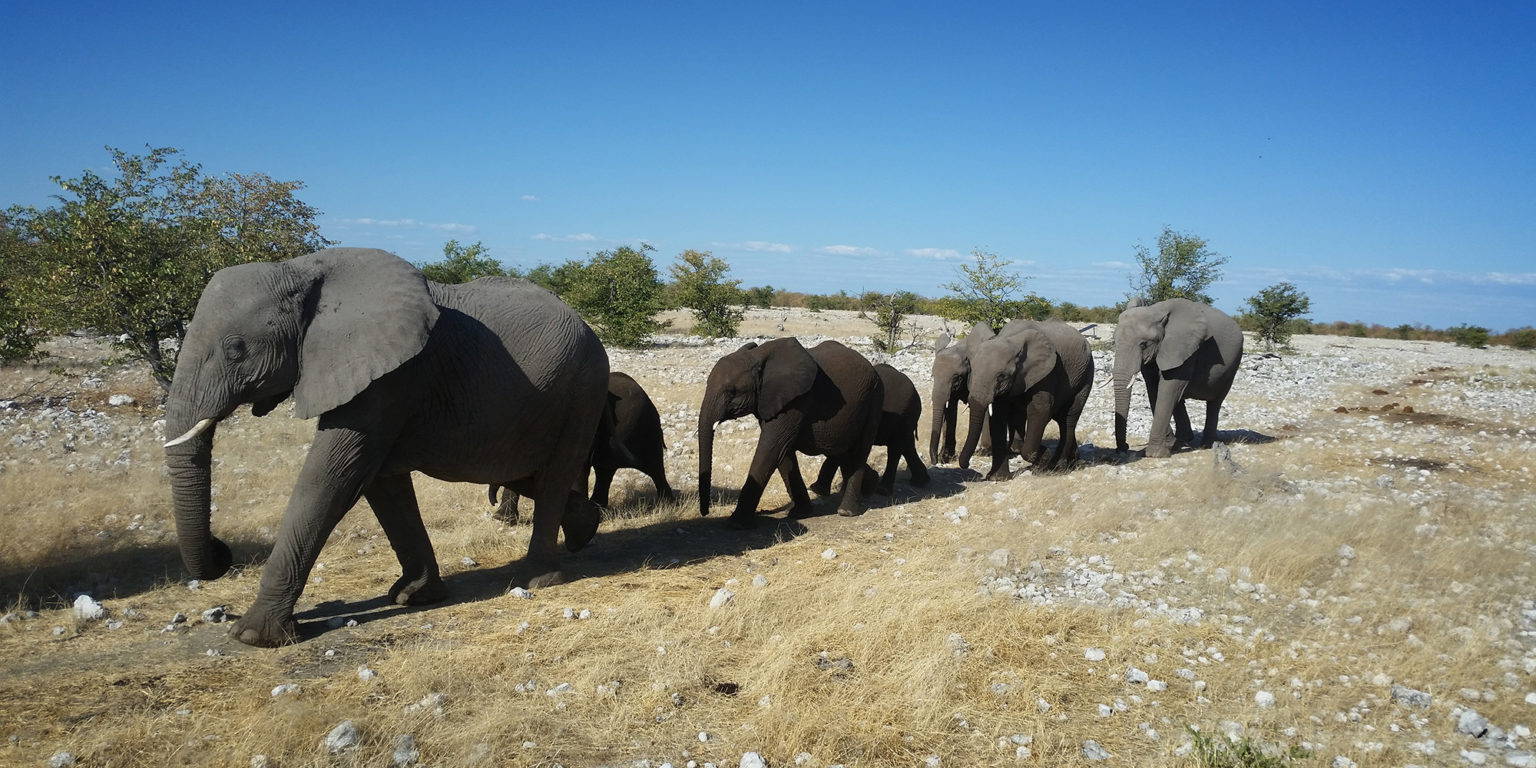
Many of the targeted Nambian elephants are from transnational herds which migrate across countries, as they have for thousands of years. This photograph is of a herd in Etosha. (Photo: Stephan Scholvin)
See Petition here
The Namibian government says it has too many elephants and that the 170 are problem-causing animals. According to professional guide and conservationist Stephan Scholvin, about 90 are to be captured on former indigenous San ancestral lands which have been seized and distributed to political elites. They sold logging rights in the area to the Chinese, who have “completely decimated” the endangered African rosewoods.
With the government just emerging from a corruption scandal exposed by Al Jazeera, resulting in the imprisonment of the Ministers of Justice and Fisheries, there is deep mistrust over its latest scheme.
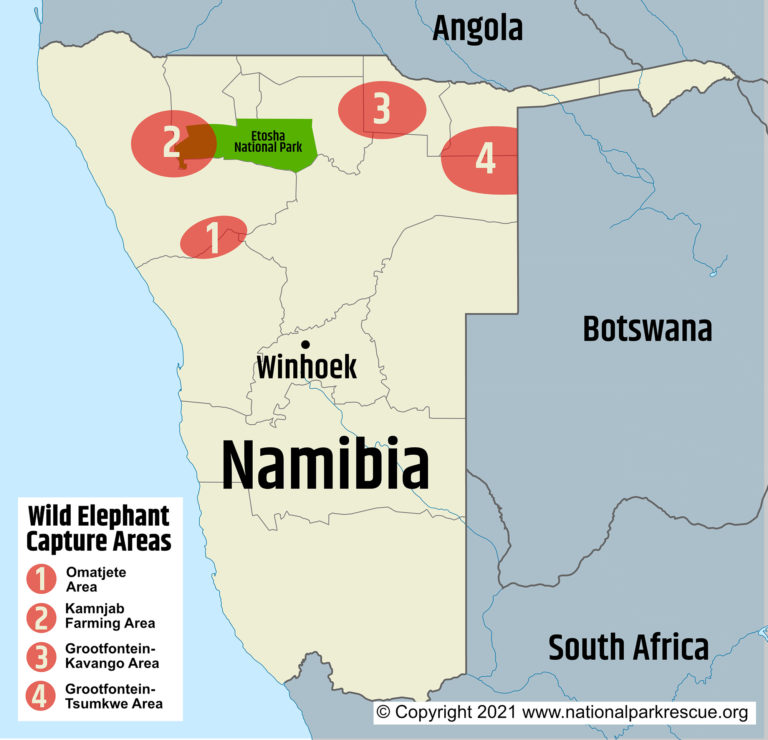
Elephant capture areas. (Image: Supplied)
Many of the targeted elephants are from transnational herds which migrate across countries, as they have for thousands of years. Conservationists argue that they do not belong to any one country for their exploitation or slaughter.
“For thousands of years,” says Mark Hiley of National Park Rescue, “matriarch elephants have been leading their herds across multiple countries on huge migrations each year. Although we’ve slaughtered 95% of all Africa’s elephants in 100 years, the last of these great herds still carry out their epic journeys. These international elephants don’t ‘belong’ to anyone and Namibia’s proposal to capture and exploit them is a crime against nature.”
The Namibian government has been falsifying its elephant population stats for years, says Hiley, “refusing to take part in official censuses, using unscientific algorithms and deliberately counting trans-boundary migratory elephant herds in their local calculations”.
“Their official statistics show 23,736 elephants, but the figure is probably closer to 5,600. Compare this to their smaller neighbour, Botswana, which has 130,000 elephants, and you can see the claims of overpopulation are ridiculous.”
Elephants are now extinct in 29 African countries and are under increasing threat from the ongoing explosion of human populations, poaching and government-sanctioned exploitation.
Namibia refused to take part in the Africa-wide Great Elephant Census of 2016, keeping its actual population numbers secret. Exaggerating population statistics and human-wildlife conflict helps governments create a range of revenue-generating initiatives including high hunting quotas, sales to zoos and hunting farms, and ivory-generating culls.
The elephants Namibia is trying to sell are actually part of a population in decline. In just one incident, more than 30 elephant carcasses were spotted in November 2020 along the Linyanti River.

The Namibian elephant capture tender. (Photo: Supplied)
Adding to the suspicion of corruption is that no mention of the sale of problem elephants was made at the recent Namibian Elephant Management Plan meeting, according to conservationists. They have proposed conflict-avoidance solutions, including elephant water points away from villages, electric fencing and elephant corridors, but the government claims it was not aware of these proposals.
Many of the elephants being targeted are in some of the lowest elephant population areas in Namibia and part of some of the highest percentages of trans-boundary elephants in the country. The government has refused to share a 2019 aerial survey alleged to contain population information, which may have been provided by WWF Namibia.
In December 2020, a government official let slip that Namibia had tried but failed to gain international permission to sell off its 50-tonne ivory stockpile, potentially to east and southeast Asia.
According to conservationists, the public auction may be a show to help justify an already planned cull of these elephants, with hunts sold to hunters under the country’s “damage-causing animals” classification. The government may have already sold hunting licences to buyers such as a Mexican millionaire who owns Erindi.com and Russian billionaire Rashid Sardarov.
According to Namibian journalist John Grobler, the tender could be an attempt to retain the rural vote after a poor showing by the South West Africa People’s Organisation (Swapo) in the recent local government elections – the strongest lobby behind the sale being the small-scale commercial farmers of Kavango East and the larger commercial farmers of Kunene and Erongo. None of them likes elephants.
Other possibilities include paid-for clearing of land for powerful cattle farming groups or oil companies. It could also be part of an international zoo deal (the tender mentions international permits).
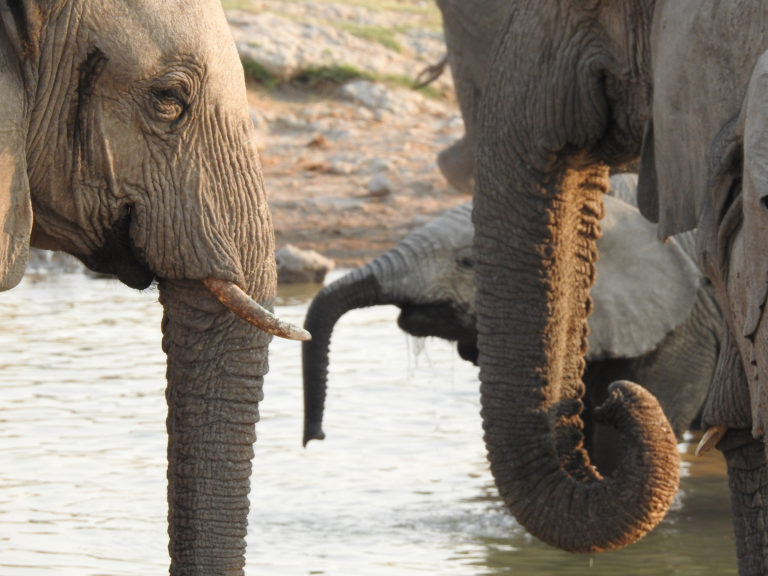
Official statistics show 23,736 elephants in Namibia, but the figure is probably closer to 5,600, says Mark Hiley of National Park Rescue. (Photo: Stephan Scholvin)
“There’s an inherent problem in how to coexist with — or manage — species that naturally migrate across imaginary human boundaries such as international borders,” says Dr Niall McCann of National Park Rescue. “From fishing rights to migratory birds to transboundary elephants, the problem remains the same: who should be allowed to exploit these animals?
“It is vital that conservation decisions are taken using the best available science. Conservation isn’t a trivial or niche topic, it is fundamental to our ability to thrive as a species and, as Covid-19 has demonstrated, making poor conservation decisions can lead to very serious unforeseen consequences.”
According to Mary Rice of the Environmental Investigations Agency, “we need to stop viewing wildlife through the lens of immediate cash return and learn to understand the value of wildlife as a living and breathing part of a functioning environment. Wildlife, including elephants, deliver tangible benefits to people in terms of ecosystem services, which will collapse if biodiversity collapses. Wildlife also delivers huge intangible benefits in terms of cultural identity and personal well-being. A land without wildlife is poorer in so many ways.”
As controversy around the sale swirls, conservationists say there are grounds for suspecting that secret, underhand deals have taken place. A year ago Al Jazeera ran a corruption investigation leading to the imprisonment of the Minister of Justice and the Minister of Fisheries, with new evidence potentially leading to more arrests. DM/OBP
Namibia selling 170 wild elephants despite outcry
By Don Pinnock• 28 January 2021

Many of the targeted Nambian elephants are from transnational herds which migrate across countries, as they have for thousands of years. This photograph is of a herd in Etosha. (Photo: Stephan Scholvin)
See Petition here
The Namibian government says it has too many elephants and that the 170 are problem-causing animals. According to professional guide and conservationist Stephan Scholvin, about 90 are to be captured on former indigenous San ancestral lands which have been seized and distributed to political elites. They sold logging rights in the area to the Chinese, who have “completely decimated” the endangered African rosewoods.
With the government just emerging from a corruption scandal exposed by Al Jazeera, resulting in the imprisonment of the Ministers of Justice and Fisheries, there is deep mistrust over its latest scheme.

Elephant capture areas. (Image: Supplied)
Many of the targeted elephants are from transnational herds which migrate across countries, as they have for thousands of years. Conservationists argue that they do not belong to any one country for their exploitation or slaughter.
“For thousands of years,” says Mark Hiley of National Park Rescue, “matriarch elephants have been leading their herds across multiple countries on huge migrations each year. Although we’ve slaughtered 95% of all Africa’s elephants in 100 years, the last of these great herds still carry out their epic journeys. These international elephants don’t ‘belong’ to anyone and Namibia’s proposal to capture and exploit them is a crime against nature.”
The Namibian government has been falsifying its elephant population stats for years, says Hiley, “refusing to take part in official censuses, using unscientific algorithms and deliberately counting trans-boundary migratory elephant herds in their local calculations”.
“Their official statistics show 23,736 elephants, but the figure is probably closer to 5,600. Compare this to their smaller neighbour, Botswana, which has 130,000 elephants, and you can see the claims of overpopulation are ridiculous.”
Elephants are now extinct in 29 African countries and are under increasing threat from the ongoing explosion of human populations, poaching and government-sanctioned exploitation.
Namibia refused to take part in the Africa-wide Great Elephant Census of 2016, keeping its actual population numbers secret. Exaggerating population statistics and human-wildlife conflict helps governments create a range of revenue-generating initiatives including high hunting quotas, sales to zoos and hunting farms, and ivory-generating culls.
The elephants Namibia is trying to sell are actually part of a population in decline. In just one incident, more than 30 elephant carcasses were spotted in November 2020 along the Linyanti River.

The Namibian elephant capture tender. (Photo: Supplied)
Adding to the suspicion of corruption is that no mention of the sale of problem elephants was made at the recent Namibian Elephant Management Plan meeting, according to conservationists. They have proposed conflict-avoidance solutions, including elephant water points away from villages, electric fencing and elephant corridors, but the government claims it was not aware of these proposals.
Many of the elephants being targeted are in some of the lowest elephant population areas in Namibia and part of some of the highest percentages of trans-boundary elephants in the country. The government has refused to share a 2019 aerial survey alleged to contain population information, which may have been provided by WWF Namibia.
In December 2020, a government official let slip that Namibia had tried but failed to gain international permission to sell off its 50-tonne ivory stockpile, potentially to east and southeast Asia.
According to conservationists, the public auction may be a show to help justify an already planned cull of these elephants, with hunts sold to hunters under the country’s “damage-causing animals” classification. The government may have already sold hunting licences to buyers such as a Mexican millionaire who owns Erindi.com and Russian billionaire Rashid Sardarov.
According to Namibian journalist John Grobler, the tender could be an attempt to retain the rural vote after a poor showing by the South West Africa People’s Organisation (Swapo) in the recent local government elections – the strongest lobby behind the sale being the small-scale commercial farmers of Kavango East and the larger commercial farmers of Kunene and Erongo. None of them likes elephants.
Other possibilities include paid-for clearing of land for powerful cattle farming groups or oil companies. It could also be part of an international zoo deal (the tender mentions international permits).

Official statistics show 23,736 elephants in Namibia, but the figure is probably closer to 5,600, says Mark Hiley of National Park Rescue. (Photo: Stephan Scholvin)
“There’s an inherent problem in how to coexist with — or manage — species that naturally migrate across imaginary human boundaries such as international borders,” says Dr Niall McCann of National Park Rescue. “From fishing rights to migratory birds to transboundary elephants, the problem remains the same: who should be allowed to exploit these animals?
“It is vital that conservation decisions are taken using the best available science. Conservation isn’t a trivial or niche topic, it is fundamental to our ability to thrive as a species and, as Covid-19 has demonstrated, making poor conservation decisions can lead to very serious unforeseen consequences.”
According to Mary Rice of the Environmental Investigations Agency, “we need to stop viewing wildlife through the lens of immediate cash return and learn to understand the value of wildlife as a living and breathing part of a functioning environment. Wildlife, including elephants, deliver tangible benefits to people in terms of ecosystem services, which will collapse if biodiversity collapses. Wildlife also delivers huge intangible benefits in terms of cultural identity and personal well-being. A land without wildlife is poorer in so many ways.”
As controversy around the sale swirls, conservationists say there are grounds for suspecting that secret, underhand deals have taken place. A year ago Al Jazeera ran a corruption investigation leading to the imprisonment of the Minister of Justice and the Minister of Fisheries, with new evidence potentially leading to more arrests. DM/OBP
"Education is the most powerful weapon which you can use to change the world." Nelson Mandela
The desire for equality must never exceed the demands of knowledge
The desire for equality must never exceed the demands of knowledge
- Lisbeth
- Site Admin
- Posts: 67384
- Joined: Sat May 19, 2012 12:31 pm
- Country: Switzerland
- Location: Lugano
- Contact:
Re: Elephant Management and Poaching in Other African Countries
ZIM DUPED OF US$13MIL IN ELEPHANT EXPORT DEALS TO CHINA, DUBAI
BY - 14TH MARCH 2021 - NEWSDESKZIM
The Zimbabwe Parks and Wildlife Management Authority may have misled the Convention on Trade in Endangered Species of Flora and Fauna (CITES) when it reported having sold 97 baby elephants to China and Dubai in the period 2012 to 2017, but was duped of US$13 million in potential revenue by Chinese buyers, middlemen and corrupt local officials.
In a new report that details corruption in the live wildlife trade between China and Zimbabwe, international investigative journalist and filmmaker Karl Amman said the Zimbabwean government figure of 97 elephants sold did not include a 2015 shipment of 24 baby elephants to Qinguyan Safari Park in China.
A collation of shipment data, customs invoicing and information from Chinese safari park tenders for African elephants shows that contrary to government reports, Zimbabwe actually sold 141 elephants to China and Dubai in the period 2012 to 2017.
While Zimparks may have misled CITES by not declaring some live elephant imports, it was creamed off millions by Chinese safaris and middlemen who bought the elephants for prices ranging between US$14 500 and US$32 000 each to resell at between US$120 000 and US$128 000 each in China.
“Irrespective of the numbers sold, what is equally interesting is that the revenue declared by Zimparks is around US$32 000 per elephant.
“The issue here is that we have ample evidence that the end purchasers paid a lot more than US$32 000 per elephant,” Amman said.
The report also suggests that in some cases, Zimparks actually charged much more than the US$32 000 it reported for each elephant, while foreign buyers and middlemen did not report that some of the animals were meant to be further sold, rented out to zoos or other forms of onward trading.
Eleven of the last 32 baby elephants imported by Longmont in 2019 were immediately sold to another zoo at three times the sales value paid to Zimparks.
“Regarding the last 32 elephants exported to Longmont Safari Park, 11 were further sold to (Ordos City Longsheng Wildlife Park Company Limited), one of the biggest traditional Chinese medicine and tiger wine producers, and one was killed in a fight with another elephant.
“The importers declared that they paid US$120 000 per elephant. This price is declared in a number of customs and importation documents”
The 2017 shipment to China also involved documented onward trading in which Ordos City Longsheng Wildlife Park sold four baby elephants bought in Zimbabwe for less than US$30 000 each for around US$128 000 each, almost four times the buying price.
Amman said a South African wildlife dealer involved in securing the elephants sold to Dubai in 2015 said Zimparks was paid US$100 000 per elephant.
“Overall, it is clear that source country Zimbabwe ended with only 25% of what the end purchasers paid,” Amman said.
“How is the remaining 75% shared? There are transport costs, and then all the bribes, kickbacks and commissions to a range of players.
“In the case of Zimbabwe, these include well-known Chinese brokers. There is also reliable information that some Zimparks board officials cashed in, and there are two brokers/agents listed in China who would have added their margins.
“If 140 elephants were sold for US$432 000 each and the price collected from the end purchasers was averaged US$125 000, we are talking of some US$13 020 000 missing, which would have made a difference on many fronts,” Amman said.
Corruption, bribery and fraud is also a major problem amid reports that in Southern Africa, corrupt CITES officials generally demand bribes of up to US$160 for each permit per shipment.
Amman said the import and customs declaration information supplied by Chinese wildlife importers were often reliable because there is no incentive or motivation to lie since China does not charge import duty or value-added-tax on African elephant imports.
Efforts to get a comment from Zimparks spokesman Tinashe Farawo were fruitless.
Zimbabwe has been selling live animals to other countries across the world for a long time now and, in 1983, the southern African country made history by becoming the first country on the continent to send away live elephants.
Zimbabwe continued to export jumbos in subsequent years during which alleged fake CITES permits were used.
This raised eyebrows among wildlife conservationists as well as animal activists who repeatedly complained that there was lack of transparency in the exportations.
“We ended up suing the government in May this year, for lack of access to information regarding the exports,” a Harare-based environmental lawyer working with Advocates4Earth, Lenin Chisaira, told The Standard last year.
According to Chisaira, there was suspicion that Zimbabwe was failing to satisfy the basic principles of animal welfare that include provision of a suitable environment and diet, proper housing, and protection from pain, trauma and disease.
The High Court challenge against the exportation of the baby elephants is yet to be heard despite being filed as an urgent application but even if that were to happen anytime, it would be academic as chances of the return of the animals are minimal.
In 2019, Zimparks released a statement claiming that it had made some US$3,2 million from 2016, selling 101 elephants and using all of the money on operational costs that included the purchase of rough-terrain Toyota Landcruisers.
The authority also bought vehicle spare parts, introduced dog patrols with part of the money and boosted its armoury with ammunition worth US$192 000.
Zimparks said it had received the green-light to export from the Office of the President and Cabinet. A Chinese businesswoman, who lives in Zimbabwe, has in the past been named as one of the kingpins behind the illicit trade in baby elephants.
She reportedly has connections with top Zimbabwean government and security officials, who allow her to operate with impunity.
Also read here: https://www.africawild-forum.com/viewto ... 75#p514675
Original article: http://www.newsdzezimbabwe.co.uk/2021/0 ... t.html?m=1
BY - 14TH MARCH 2021 - NEWSDESKZIM
The Zimbabwe Parks and Wildlife Management Authority may have misled the Convention on Trade in Endangered Species of Flora and Fauna (CITES) when it reported having sold 97 baby elephants to China and Dubai in the period 2012 to 2017, but was duped of US$13 million in potential revenue by Chinese buyers, middlemen and corrupt local officials.
In a new report that details corruption in the live wildlife trade between China and Zimbabwe, international investigative journalist and filmmaker Karl Amman said the Zimbabwean government figure of 97 elephants sold did not include a 2015 shipment of 24 baby elephants to Qinguyan Safari Park in China.
A collation of shipment data, customs invoicing and information from Chinese safari park tenders for African elephants shows that contrary to government reports, Zimbabwe actually sold 141 elephants to China and Dubai in the period 2012 to 2017.
While Zimparks may have misled CITES by not declaring some live elephant imports, it was creamed off millions by Chinese safaris and middlemen who bought the elephants for prices ranging between US$14 500 and US$32 000 each to resell at between US$120 000 and US$128 000 each in China.
“Irrespective of the numbers sold, what is equally interesting is that the revenue declared by Zimparks is around US$32 000 per elephant.
“The issue here is that we have ample evidence that the end purchasers paid a lot more than US$32 000 per elephant,” Amman said.
The report also suggests that in some cases, Zimparks actually charged much more than the US$32 000 it reported for each elephant, while foreign buyers and middlemen did not report that some of the animals were meant to be further sold, rented out to zoos or other forms of onward trading.
Eleven of the last 32 baby elephants imported by Longmont in 2019 were immediately sold to another zoo at three times the sales value paid to Zimparks.
“Regarding the last 32 elephants exported to Longmont Safari Park, 11 were further sold to (Ordos City Longsheng Wildlife Park Company Limited), one of the biggest traditional Chinese medicine and tiger wine producers, and one was killed in a fight with another elephant.
“The importers declared that they paid US$120 000 per elephant. This price is declared in a number of customs and importation documents”
The 2017 shipment to China also involved documented onward trading in which Ordos City Longsheng Wildlife Park sold four baby elephants bought in Zimbabwe for less than US$30 000 each for around US$128 000 each, almost four times the buying price.
Amman said a South African wildlife dealer involved in securing the elephants sold to Dubai in 2015 said Zimparks was paid US$100 000 per elephant.
“Overall, it is clear that source country Zimbabwe ended with only 25% of what the end purchasers paid,” Amman said.
“How is the remaining 75% shared? There are transport costs, and then all the bribes, kickbacks and commissions to a range of players.
“In the case of Zimbabwe, these include well-known Chinese brokers. There is also reliable information that some Zimparks board officials cashed in, and there are two brokers/agents listed in China who would have added their margins.
“If 140 elephants were sold for US$432 000 each and the price collected from the end purchasers was averaged US$125 000, we are talking of some US$13 020 000 missing, which would have made a difference on many fronts,” Amman said.
Corruption, bribery and fraud is also a major problem amid reports that in Southern Africa, corrupt CITES officials generally demand bribes of up to US$160 for each permit per shipment.
Amman said the import and customs declaration information supplied by Chinese wildlife importers were often reliable because there is no incentive or motivation to lie since China does not charge import duty or value-added-tax on African elephant imports.
Efforts to get a comment from Zimparks spokesman Tinashe Farawo were fruitless.
Zimbabwe has been selling live animals to other countries across the world for a long time now and, in 1983, the southern African country made history by becoming the first country on the continent to send away live elephants.
Zimbabwe continued to export jumbos in subsequent years during which alleged fake CITES permits were used.
This raised eyebrows among wildlife conservationists as well as animal activists who repeatedly complained that there was lack of transparency in the exportations.
“We ended up suing the government in May this year, for lack of access to information regarding the exports,” a Harare-based environmental lawyer working with Advocates4Earth, Lenin Chisaira, told The Standard last year.
According to Chisaira, there was suspicion that Zimbabwe was failing to satisfy the basic principles of animal welfare that include provision of a suitable environment and diet, proper housing, and protection from pain, trauma and disease.
The High Court challenge against the exportation of the baby elephants is yet to be heard despite being filed as an urgent application but even if that were to happen anytime, it would be academic as chances of the return of the animals are minimal.
In 2019, Zimparks released a statement claiming that it had made some US$3,2 million from 2016, selling 101 elephants and using all of the money on operational costs that included the purchase of rough-terrain Toyota Landcruisers.
The authority also bought vehicle spare parts, introduced dog patrols with part of the money and boosted its armoury with ammunition worth US$192 000.
Zimparks said it had received the green-light to export from the Office of the President and Cabinet. A Chinese businesswoman, who lives in Zimbabwe, has in the past been named as one of the kingpins behind the illicit trade in baby elephants.
She reportedly has connections with top Zimbabwean government and security officials, who allow her to operate with impunity.
Also read here: https://www.africawild-forum.com/viewto ... 75#p514675
Original article: http://www.newsdzezimbabwe.co.uk/2021/0 ... t.html?m=1
"Education is the most powerful weapon which you can use to change the world." Nelson Mandela
The desire for equality must never exceed the demands of knowledge
The desire for equality must never exceed the demands of knowledge


